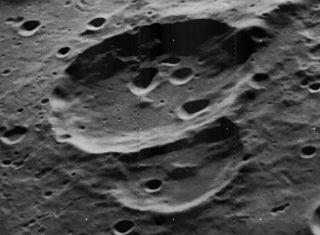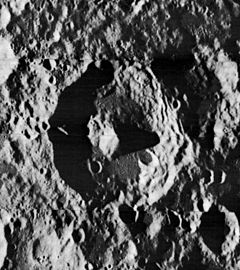
Daedalus is a prominent crater located near the center of the far side of the Moon. The inner wall is terraced, and there is a cluster of central peaks on the relatively flat floor. Because of its location, it has been proposed as the site of a future giant radio telescope, which would be scooped out of the crater itself, much like the Arecibo radio telescope, but on a vastly larger scale.

Fra Mauro is the worn remnant of a walled lunar plain. It is part of the surrounding Fra Mauro formation, being located to the northeast of Mare Cognitum and southeast of Mare Insularum. Attached to the southern rim are the co-joined craters Bonpland and Parry, which intrude into the formation forming inward-bulging walls. The crater is named after Italian geographer Fra Mauro.

Beaumont is a lava-flooded crater located on the southwestern shore of the Mare Nectaris on Earth's Moon. It lies to the northwest of the similarly flooded crater remnant Fracastorius. To the west is the prominent crater Catharina. The crater is named after French geologist Léonce Élie de Beaumont.

Al-Khwarizmi is a lunar impact crater located on the far side of the Moon. It lies to the southeast of the crater Moiseev, and northeast of Saenger.

Amici is a lunar impact crater that is located on the rugged far side of the Moon. It lies to the south of the larger crater Icarus, to the north of McKellar.

Anders is a worn lunar impact crater that is located in the southern hemisphere on the far side of the Moon. It lies just to the southeast of the outer rim of the huge walled basin named Apollo. To the south-southeast is the crater Leavitt.

Burnham is a small crater located to the southeast of the crater Albategnius, in a relatively smooth area of the lunar surface. It was named after American astronomer Sherburne W. Burnham. To the southwest is Vogel.

Sulpicius Gallus is a small, bowl-shaped lunar impact crater that lies near the southwestern edge of the Mare Serenitatis. The crater is named after the 2nd century BC Roman astronomer Gaius Sulpicius Gallus.

Anděl is a lunar impact crater that lies in the rugged central highlands of the Moon. It was named after the Czech astronomer Karel Anděl. Nearby craters of note include Abulfeda to the south-southeast and Descartes to the east-southeast. About 85 kilometres to the east-northeast of the outer rim is the landing site of the Apollo 16 mission.

Borman is a lunar impact crater that is located in the southern hemisphere on the far side of the Moon. It lies across the southeast section of the mountainous inner ring, within the walled basin named Apollo.

Barringer is a lunar impact crater that is located on the southern hemisphere on the Far side of the Moon, named after geologist Daniel Barringer. It is attached to the north-northeastern rim of the walled basin named Apollo, and lies to the southeast of Plummer. South of Barringer, on the floor of the Apollo basin, is the crater Scobee.

Barbier is a lunar impact crater that is located on the southern hemisphere on the far side of the Moon. It forms a matched pair with Cyrano to the north-northwest, and it lies to the southeast of the huge walled plain Gagarin. Southwest of Barbier is the crater Sierpinski, and to the southeast is the Mare Ingenii.

Chaffee is a lunar impact crater that is located in the southern hemisphere on the far side of the Moon. It lies within the huge walled plain Apollo, and is one of several craters in that formation named for astronauts and people associated with the Apollo program. This basin is a double-ringed formation, and the crater Chaffee is situated across the southwest part of the inner ring. The ridge from this ring extends northward from the northern rim of Chaffee.

Dryden is a lunar impact crater that is located on the southern hemisphere on the far side of the Moon. It lies within the huge walled plain called Apollo, and is one of several features within that basin named after people associated with the Apollo program. Apollo itself has an inner ring, and Dryden is attached to the west-northwest part of that circular mountain formation. To the south of Dryden along the same range is the crater Chaffee.

Lovell is a small lunar impact crater that lies across the eastern edge of the walled plain Apollo, on the far side of the Moon. It has a somewhat irregular shape, with outward bulges to the north and west. The rim is sharp-edged, with some slight wear along the northwestern bend. The featureless inner walls slope directly down to the uneven interior floor.

Frost is a lunar impact crater that is attached to the southern rim of the walled plain Landau, and lies on the far side of the Moon. Just to the east is Petropavlovskiy, and to the northeast along the edge of Landau is Razumov. The crater Douglass is located less than a crater diameter to the west-southwest.

Grissom is a lunar impact crater that lies on the far side of the Moon. It is located just to the south of the huge walled plain Apollo, and to the northeast of the crater Cori. The rim of Grissom is eroded in places, particularly along the northeast where a pair of small craters lie along the sides. There is a clustering of small craterlets located to the south of the crater midpoint. A small crater lies along the northeast edge of the floor.

Lobachevskiy is a lunar impact crater that is located on the far side of the Moon, beyond the eastern limb. It was named after Russian mathematician Nikolai Lobachevsky in 1961. This crater lies to the southeast of the larger crater Fleming. Less than a crater diameter to the east-northeast lies Guyot.

White is a lunar impact crater. It lies on the far side of the Moon from the Earth, to the southwest of the huge walled plain Apollo. About one crater diameter to the south-southwest is the small crater Hendrix.

Plummer is a lunar impact crater. It is located on the far side of the Moon from the Earth, to the north of the huge walled plain Apollo. Less than one crater diameter to the north of Plummer is the similar-sized Wilsing.






















